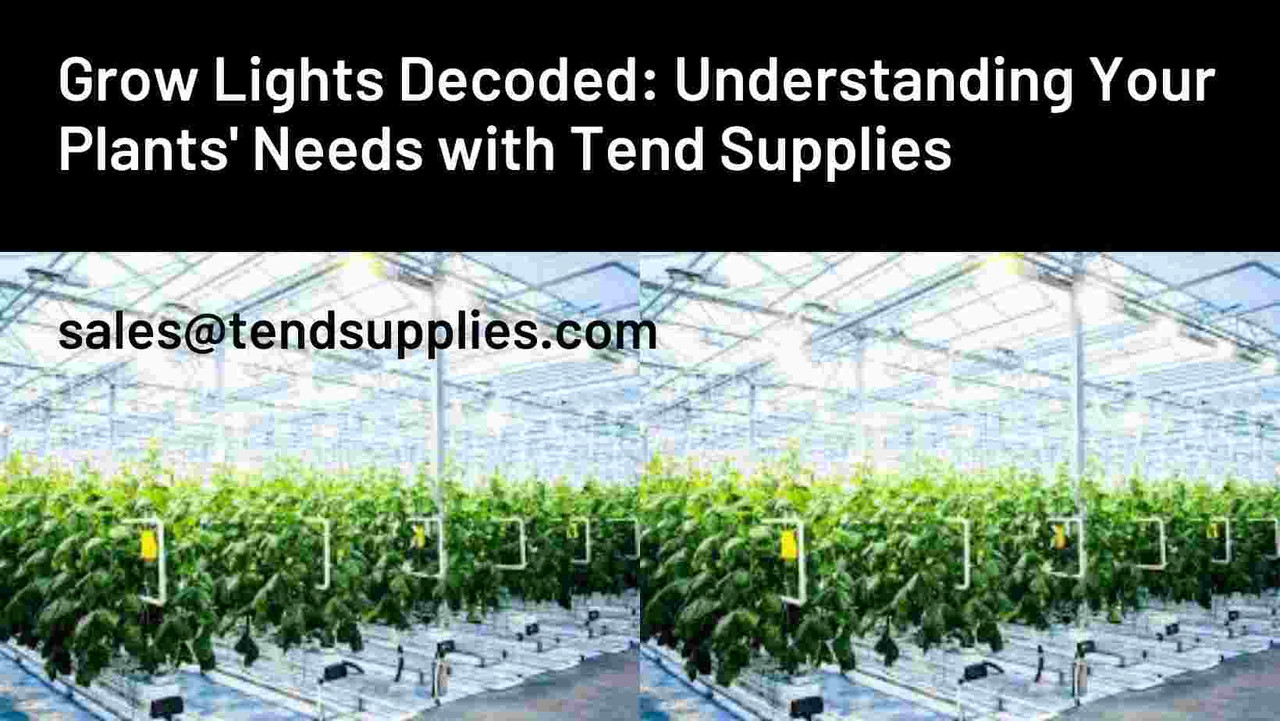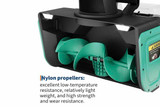Grow Lights Decoded: Understanding Your Plants' Needs with Tend Supplies
Thanks to technological advancements, such as grow lights, indoor gardening has transformed from a hobby to a sophisticated practice of horticulture. At Tend Supplies, we understand that the proper lighting can make a significant difference in the health and productivity of your plants. This comprehensive guide will delve into the science behind grow lights and how they impact plant growth, equipped with insights from our experts at Tend Supplies.
Key Takeaway from this Article
The correct utilization of grow lights can transform an indoor gardening venture from mere hobby to a prolific green haven. Tend Supplies provides not just the tools but also the necessary expertise to ensure that your garden thrives under the best possible conditions.
The Science of Grow Lights
Grow lights are not just replacements for sunlight; they are advanced tools designed to optimize plant growth by replicating the natural solar spectrum. Here’s how they work:
- Electromagnetic Spectrum: Sunlight includes a range of electromagnetic waves from ultraviolet (UV) to infrared (IR), each with a specific role in plant physiology. Grow lights mimic this spectrum to provide the necessary light for photosynthesis and other growth-related processes.
- Photosynthesis Optimization: Chlorophyll, the green pigment in plants, absorbs light most effectively in the blue and red wavelengths. Grow lights are engineered to emit peak wavelengths within these ranges to enhance photosynthesis efficiency, promoting faster growth and healthier plants.
Types of Grow Lights
Choosing the correct type of grow light is crucial for meeting your indoor garden's specific needs. Tend Supplies offers a variety of grow lights, each with unique benefits:
- LEDs (Light Emitting Diodes): Highly energy-efficient and capable of producing a spectrum tuned for all growth stages, LEDs are ideal for most indoor gardening applications.
- Fluorescent Bulbs: These are great for seedlings and small plants, emitting a broad light spectrum that supports early growth stages.
- High-Intensity Discharge (HID): Powerful and effective for larger gardens, HIDs promote vigorous growth but tend to run hotter and use more energy than other types.
Understanding Light Spectrum and Its Importance
The light spectrum plays a pivotal role in plant development:
- Blue Light (400-500 nm): Crucial during the vegetative growth phase, blue light promotes strong leaf growth and regulates plant morphology.
- Red Light (620-750 nm): Important for the flowering and fruiting stages, red light influences hormone regulation and can significantly impact yield quality and quantity.
Each type of grow light provides different ratios of these essential wavelengths, and understanding the balance can help you choose the right light for your plants.
This initial exploration into the science of grow lights sets the stage for a deeper understanding of how Tend Supplies can meet the specific needs of your indoor garden. By choosing the appropriate grow lights, you are not just illuminating your plants but enhancing their life processes, ensuring robust growth and bountiful yields. Stay tuned as we continue to unveil how you can optimize your indoor gardening setup with the right lighting solutions.
Maximizing Plant Health with Optimized Lighting Solutions
At Tend Supplies, we provide a variety of grow lights and ensure that our customers understand how to use these tools to achieve optimal results. Here’s how to fine-tune your lighting setup for maximum effectiveness:
Tailoring Light Intensity and Duration
Proper management of light intensity and duration is critical for mimicking the natural conditions plants would experience outdoors:
- Light Intensity: This should be adjusted according to the plant's stage of growth. Young seedlings require less intense light to prevent scorching, while mature plants thrive under stronger light to maximize photosynthesis.
- Duration of Light Exposure: Also known as photoperiod, this varies significantly between species and growth phases. Most edible species require longer periods of light during the vegetative stage and less during the blooming phase. Using timers to regulate light cycles can automate this process, making light management effortless and precise.
Strategic Light Placement
The positioning of grow lights can greatly influence their efficiency:
- Uniform Light Distribution: Ensure that light evenly covers the plant canopy. Uneven light can lead to irregular growth, so adjusting the placement of lights or using reflective materials to disperse light can help avoid hotspots and shadow zones.
- Adjustable Height: As plants grow, the optimal distance between the plants and light sources changes. Lights that are too close can cause heat damage, while too far away lights may be ineffective. Adjustable hanging systems allow you to maintain the ideal distance throughout your plant's lifecycle.
Integration with Environmental Controls
Optimal lighting goes hand-in-hand with overall environmental control, including temperature, humidity, and ventilation:
- Thermal Management: LED lights generate less heat than HID lamps, making them easier to integrate into climate-controlled environments. However, proper ventilation is still necessary to maintain ambient temperatures that support plant health.
- Humidity and Circulation: Plants transpire and add moisture to the air, affecting light efficiency and plant health if not properly managed. Use dehumidifiers and fans to maintain ideal humidity and air movement.
Case Studies: Success with Tend Supplies Grow Lights
To illustrate the impact of well-chosen grow lights, consider these testimonials from Tend Supplies customers:
- Urban Herb Garden: A customer successfully cultivated a variety of herbs in a small apartment using our compact LED systems. The controlled light spectrum was perfect for herbs like basil and cilantro, leading to a 30% increase in yield compared to previous setups.
- Commercial Greenhouse Application: A commercial grower switched to our high-output LED panels for a tomato greenhouse and observed a 50% increase in fruit production. The ability to dial in the perfect red-to-blue ratio made a significant difference.
By addressing these common lighting issues and implementing the suggested solutions, gardeners can significantly enhance the performance and yield of their indoor gardens.
Stay tuned for the final segment, in which we'll provide actionable tips and further insights to help you refine your indoor gardening strategies with Tend Supplies.
Enhancing Indoor Gardening Success with Advanced Lighting Techniques
Understanding and implementing advanced lighting strategies are essential for any serious indoor gardener. Tend Supplies is dedicated to providing products and the knowledge that empowers our customers to use these tools effectively for maximum plant health and productivity.
Advanced Lighting Manipulations
Leveraging advanced lighting techniques can significantly improve plant growth and yield:
- Spectral Adjustments: With adjustable LED grow lights, gardeners can change the light spectrum based on the plant's growth stage. For example, increasing blue light during the vegetative phase and red light during the flowering phase can dramatically enhance growth efficiency and yield.
- Dynamic Daylight Simulation: Mimic natural sunlight variations throughout the day using programmable LED systems that adjust light intensity gradually. This technique can help regulate plant biological cycles more naturally, leading to healthier growth.
Integrating Smart Technology
Smart grow lights, including Wi-Fi connectivity and app control, are revolutionizing indoor gardening. They allow for remote monitoring and adjustments, which is particularly beneficial for gardeners with extensive setups or those who travel frequently.
FAQs
Q1: What is the best distance between grow lights and plants?
A1: This distance varies depending on the light type and plant species, but generally, LED lights should be positioned 12-24 inches above the plant canopy to balance light intensity and coverage.
Q2: How can I tell if my plants are getting enough light?
A2: Look for signs of healthy growth, such as strong, vibrant leaves. Stunted growth, small leaves, or long, thin stems (etiolation) often indicate inadequate lighting.
Q3: Are LED grow lights better than HID lights?
A3: LED lights are generally more energy-efficient, produce less heat, and can provide a tailored light spectrum ideal for all growth stages, making them a better choice for most indoor gardens.
Q4: Can I use grow lights for all types of plants?
A4: Yes, grow lights can support a wide range of plants, from common houseplants to vegetables and herbs, provided the light's intensity and spectrum are suitable for the specific types of plants.
Q5: How often should I replace my grow lights?
A5: LED grow lights typically last several years (up to 50,000 hours). If you notice a significant decrease in brightness or efficiency, check the manufacturer's guidelines and replace the lights.
Buy From TendSupplies
Elevate your indoor garden with state-of-the-art lighting solutions from Tend Supplies. Visit tendsupplies.com to browse our extensive range of grow lights and learn more about optimizing your plant care routine. Whether you are just starting or looking to upgrade your existing setup, Tend Supplies has everything you need to grow smarter. Contact us today at sales@tendsupplies.com for personalized advice tailored to your unique gardening needs.
Let Tend Supplies light up your indoor gardening journey with advanced solutions that promise growth and success. Join our community, and let us help you cultivate a vibrant and productive garden that becomes the envy of every plant enthusiast!








